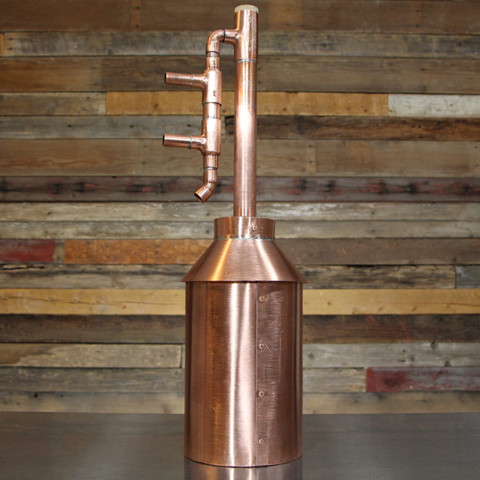Why Distillation Equipment Should Be Essential To Your SHTF Prep

Why Distillation Equipment Should Be Essential To your SHTF Prep
Why should distillation equipment be added to your prepper equipment checklist? Here are 3 excellent reasons, to name a few: distilled spirits, fuel alcohol, and antiseptic. These goods would be highly valuable during an event where there is a total breakdown of supply chains, government oversight, etc. and can all be easily manufactured with simple, small-scale distillation equipment. As a bonus, all of these goods would be highly desirable in a barter economy.
Whiskey
Let’s start with the most fun commodity made possible by distillation equipment; distilled spirits. Spirits are made by first concocting low strength (8-10%) alcohol, which is accomplished by mashing and fermenting grains, just like one would do when making beer. With the additional step of distillation, alcohol content is increased to a concentration somewhere in the neighborhood of 40-50% (which corresponds to 80-100 proof).
The crafting of homemade spirits is really a pretty simple process; it is much less complicated than one might think. However, the process also has somewhat of a troubled past, which incorrectly leads many people to believe that spirits cannot safely be made at home. During prohibition in the United States, alcohol production was banned, but demand remained high. As taps at the distilleries ran dry, whiskey began to flow from mountain hollers. City dwellers abandoned their above-board watering holes and took to back alley speakeasies. The whiskey production process fell into the hands of organized criminals. Some took pride in their products, but others were unscrupulous bootleggers who sought to maximize production improve profit margins by using shoddy distillation equipment and by cutting otherwise good alcohol with toxic chemicals. The result was isolated instances where bootleg whiskey injured its consumer. As a result of this chain of events, homemade alcohol inherited a tarnished reputation that still survives to this day.
Some still believe that homemade spirits cause lead poisoning and blindness and should never be trusted. Others know better! Home distillation is actually quite straightforward, fairly simple, and safe. So long as one adheres to a few ground rules for making whiskey safely, they’ll be able to make their own spirits without worry.
If you’re a prepper and you also enjoy distilled spirits, distillation equipment is a must. If you’re a prepper and libations aren’t you thing, keep reading. There are plenty of other reasons you still might want to consider investing in a still.
Water
Despite the fact that distilled water is produced and consumed in many areas where fresh water is not abundant, the health impact of drinking distilled water is somewhat of a contentious issue. Some claim that distilled water is better for human health than regular water. Others claim that long term consumption of distilled water will negatively impact human health (due to its reduced nutrient content). Regardless of your position on the issue, the ability to distill water would definitely be useful during an SHTF event. Distilling water is a highly effective way to remove impurities. Once distilled the water has multiple uses; It can be drank (at least on a short-term basis), used for medical applications, used for cleaning, used to calibrate scientific equipment, etc.
Fuel
Fuel is included on many, if not all survival prep lists. Here are a few things to keep in mind on this topic: first, that there are many types of fuel and the different types have different uses. Second, a good fuel strategy is one that provides fuel based on expected need as well as one that provides provisions for replenishment. We’ll address all of these issues below.
The two primary fuel categories are stationary and mobile. Here are examples to help clarify. Wood and coal are both stationary fuels and are appropriate for heating and cooking, in a set location. Gasoline and diesel are mobile fuels and are appropriate for powering mobile equipment such as cars, motorcycles, and tractors.
Some fuels can be used as stationary and mobile fuels while others cannot be or at least should not be. For example, wood is great for heating and cooking but it’s useless as a mobile fuel. Gasoline, a mobile fuel, will power a small engine, but it’s not the best for cooking, and relying on it as a long term heating strategy would be very unwise considering the amount of fuel that one would need to keep on hand.
Finally, mobile fuels such as gasoline, diesel, and kerosene have limited shelf lives and will be subject to supply issues during instances of widespread infrastructure meltdowns.
Considering the above mentioned facts, one potential fuel supply strategy would involve a good stockpile of wood and relative close proximity to a source for more, as well as a renewable mobile fuel source. Because the mobile fuels listed above will be subject to supply limitations and producing them will be very difficult, if not impossible, we cannot recommend them. Natural gas and propane could also be used as mobile (and stationary fuels), but they’re subject to the same limitations as the others. Fortunately, there is a mobile fuel that is quite easy to produce, keeps well, and doubles as a mobile as well as a stationary fuel: alcohol.
To use alcohol as a fuel in a small engine, it must be 100% pure. This is an issue, albeit only a small one, as fuel alcohol produced by means of distillation maxes out at a purity of 95%. Re-distilling will not result in a higher proof product. To remove the last bit of water from the fuel, it must be treated with a drying agent. Fortunately, corn grits actually work very well to accomplish this.
Fuel alcohol can be produced in any still but column stills are the most appropriate for this task, as they’re more efficient at making the high alcohol content need for use in engines. Though, considering that there are many uses for alcohol, all requiring different proofs, the best still for a prepper would be a hybrid still. Hybrid stills employ the use of a column which can either be packed, and used as a reflux still for fuel alcohol, or can be left empty for making whiskey, antiseptic, and distilled water.
Antiseptic/Disinfectant
There are plenty of other uses for alcohol aside from drinking and burning it. For example, high strength ethyl alcohol (the kind produced by fermenting sugar and then concentrating it with a still) is a versatile product that doubles as an antiseptic as well as a disinfectant. This means that it’s effective at cleaning wounds but can also be used to clean hard surfaces. It’s a broad-spectrum antimicrobial and is highly effective at killing bacteria, viruses, and fungi. Antiseptic and disinfectants are very useful and should be considered highly valuable by SHTF preppers.
There is one very important piece of information that one should consider when producing antiseptic: the strength of the alcohol greatly alters its effectiveness and stronger is not always better. Generally, the antimicrobial activity of alcohol is significantly lower at concentrations below 50%. So, when producing antiseptic, make sure that it’s at least 50% alcohol. Also, the optimal strength is in the 60 to 90% range. That’s where the “stronger is not always better” rule comes into play. Interestingly enough, applying alcohol stronger than 90% to a wound actually disrupts the body’s natural healing process. Rubbing alcohol sold in stores is about 70% alcohol and that’s the strength we’d suggest you shoot for. Producing alcohol in this purity range can be accomplished with little knowledge and basic distillation equipment.
Bartering
Did you know that in 2013, Brown-Forman, the parent company of Jack Daniels and other popular alcohol brands posted $3.8 billion in gross sales? Seems like a lot of money, doesn’t it? It’s actually not a lot of cash compared to the total 2103 revenue of the world’s largest oil companies, which totaled $1.8 trillion. Also, consider this, the US healthcare industry posted similar revenues, and is roughly a $2 trillion per year industry. In case you’re not an economist, we should clarify that these figures represent a lot of money.
What are we getting at here? Well, whiskey, fuel, and health are all big industries. That’s because these things offer a lot of utility to humans. That makes things like whiskey, healthcare products, and fuel very valuable. In a situation where traditional economies fail and money becomes more or less useless, the only way individuals will be able to get things they need will be to make the goods themselves or to trade for them. Having a still and knowing how to produce valuable products with it will open up a world of opportunities for bartering in an SHTF economy.
About Kyle Brown
Coppersmith by day, old timey fiddler by night. Kyle Brown started Clawhammer Supply in 2009. While searching the web for distillation supplies, Brown couldn’t find any supplies that met his standards. So, he decided to manufacture his own 100 percent copper still. Once he perfected his design, he made additional stills with his extra materials to sell. Thus, Clawhammer Supply was born.
Visit: EZ Battery Reconditioning To Learn More here: http://www.survivalistdaily.com/ezbatteryreconditioning








As a avid homebrewer I would like to try distilling but have not because of the legality of it. Going to jail for making moonshine is not something I am ready to do.